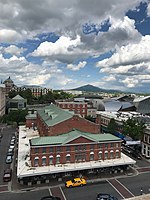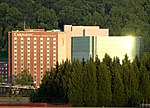Colonial National Bank (Roanoke, Virginia)

Colonial National Bank, also known as the Colonial-American National Bank and the Colonial Arms Building, is a historic bank and office building located at Roanoke, Virginia. It was built in 1926–1927, and is a 12-story, granite and gray-enamel brick building in the Neoclassical style. The building's design echoes that of a classical column; its first three stories compose the base, its shaft is composed of the next seven stories of unornamented brick, and the top two stories of ornamented brick are the capital. The building has a three-story annex built in two stages in 1949 and 1959. The structure was Roanoke's tallest building for almost fifty years. The office building was listed on the National Register of Historic Places in 1983. It has been renovated numerous times, and as of 2018 housed a bank in its lower floors and upscale apartments in the upper portion.
Excerpt from the Wikipedia article Colonial National Bank (Roanoke, Virginia) (License: CC BY-SA 3.0, Authors, Images).Colonial National Bank (Roanoke, Virginia)
Campbell Avenue Southeast, Roanoke
Geographical coordinates (GPS) Address Nearby Places Show on map
Geographical coordinates (GPS)
| Latitude | Longitude |
|---|---|
| N 37.271666666667 ° | E -79.940277777778 ° |
Address
Center in the Square Garage
Campbell Avenue Southeast 11
24011 Roanoke
Virginia, United States
Open on Google Maps










